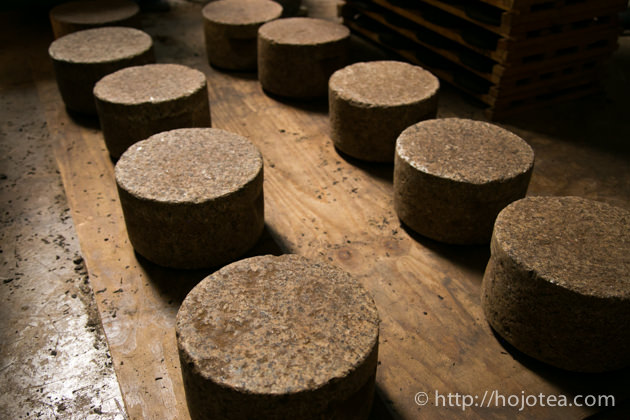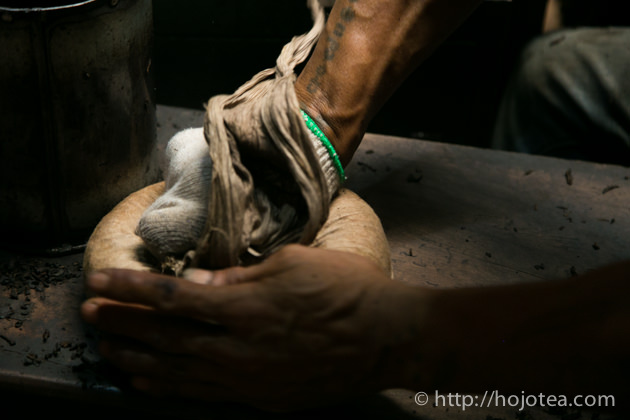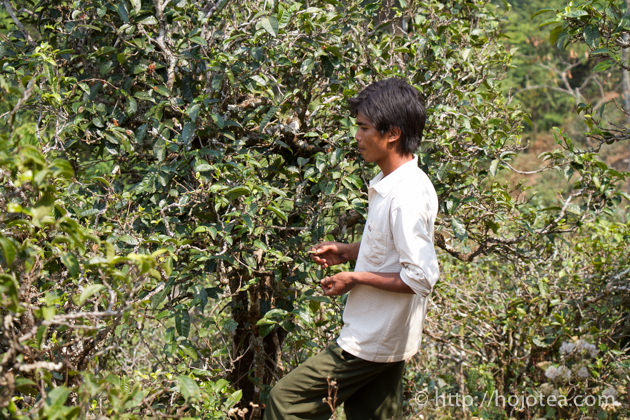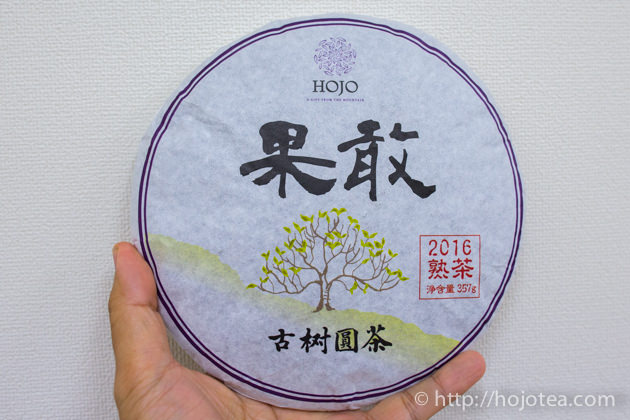- HOME >
- New Arrival at HOJO Online Shop
New Release of Guo Gan Ripe Pu-erh from Myanmar
- [2017.11.14] Posted By Akira Hojo

We released ripe pu-erh tea produced in Myanmar from the area called Guo Gan. This is very limited and rare kinds of tea. We purchased the mao-cha produced in 2016 and compressed it into 357g cake. Although tea was produced just a year ago, it is quite nice to drink it even now. Nevertheless, if we store this tea for another few years, it will develop more fruity and sweet flavor.


Tea was collected in Myanmar near the Yunnan border
In Myanmar, Guo Gan is located next to the South West Yunnan. The population of Guo Gan consists of a number of Chinese minorities. In the town of Guo Gan, many people speak Chinese and many sign boards are written in Chinese. The Guo Gan autonomous region has very strong economic linkage with Yunnan. In particular, pu-erh tea is a very important trading item for them.
In the history, there were always civil wars taking place in Guo Gan due to the conflicts between different tribes. In the past few years, they have had very severe fights and many fighter aircrafts and fire shells of trench mortar were often going around. In 2016, they have temporarily ceased the war, although a number of conflict zones are still remained.

The village of Myanmar that is just a few houses away from the national border to China. In 2013, we visited there before the civil war begun.
Primary process in Myanmar and fermentation in Yunnan
Since the conflict zones are still in great danger, the China immigration department does not allow Chinese to travel to Guo Gan at the moment.
Our tea was produced in 2016. The tea leaves were transported by farmers of Myanmar to Yunnan. They drove a track all the way to Yunnan to supply the mao-cha of raw pu-erh tea. Those farmers are the apprentices of the Yunnan pu-erh tea manufacturer. Before 2014, while Guo Gan was still in peace, the Yunnan tea manufacturer set up the factory in Guo Gan, and these farmers learned the skills of producing pu-erh tea from the Yunnan tea master.
For now, even though there is no Chinese stationed in Guo Gan, the farmers have skills to process tea. As such, the Guo Gan ripe pu-erh tea is made in the collaboration between the people of two countries.
Tea is grown without fertilizer and pesticide
Even in Yunnan province, Guo Gan ripe pu-erh tea is very rare and limited. It is because of most of the Guo Gan teas are purchased by specific people on the spot. Some people are aware of the quality of Guo Gan ripe pu-erh tea. Since the total production is not really a lot, most of Guo Gan ripe pu-erh teas are bought right at the primary processing plant.
In the past few years, the price of Guo Gan ripe pu-erh tea has been gradually increased. However, some Guo Gan tea gives astringent taste and light after taste if it is sourced from the garden near the villages. Since we are highly aware of this issue, we look for the tea that gives long lasting after taste, clear drinking sensation and rich mouth-feel.
Right now our Guo Gan 2016 ripe pu-erh tea is about one year old. It gives comfortable body with sweetish drinking sensation. However, its quality will be even greater after it is aged for a year or two.





The oxygen management affects the flavor of ripe pu-erh tea
Some people mentioned that they do not like to drink ripe pu-erh tea. It is mostly due to the prejudice that they think ripe pu-erh tea gives the odor like rotten wood, earthy, musty or moldy. I believe that the perception of the unpleasant odor is kind of defensive response that our body is trying avoid the intake of food that is not suitable for our health.
The ripe pu-erh tea undergoes the microbiological fermentation spending more than a month. During the fermentation, it is very critical to control the moisture content of the piled tea. The tea has to be agitated frequently in order to supply adequate oxygen. If too much moisture is applied or the manufacturer neglects the agitation, the oxygen inside the piled tea leaves is insufficient. As a result, the anaerobic bacteria (bacteria that does not require oxygen) dominate and it typically produces very unpleasant odor that is mentioned earlier.
In fact, many kinds of anaerobic bacteria are known to produce some toxins as well. If the tea fermentation process is well-managed with the adequate level of moisture and oxygen, the ideal fermentation is taken place by aerobic bacteria, mainly actinomyces and it produces sweet and dry-fruity flavor.
When we select ripe pu-erh tea, we care not only the base quality of tea but also how the fermentation is carried out.
As the Guo Gan Ripe Pu-erh tea was typically well-managed in fermentation, it gives no earthy or musty odor. It has mild sweet and dry-fruity flavor and with a little woodsy note.
If this tea is kept for a few more years, the flavor will be amplified, the lingering sweetness will increased, the taste gets clearer and the mouth-feel will be softer.
Related Articles
How to get the latest update on HOJO?
1. Follow Twitter, 2. Click "Like" on Facebook, and 3. Subscribe in newsletter. You can have the latest tea news from HOJO.
 Subscribe the Newsletter to enjoy the privileges
Subscribe the Newsletter to enjoy the privileges- You may receive a free sample upon purchase, or you may have the priority to purchase special products. So please remember to subscribe our newsletter as well as the social network.
- 2024 Dong Shan Raw Pu-erh Tea – Crafted with the Producer for Desired Quality
- We have released the 2024 cake of Dong Shan Raw Pu-erh Tea. Earlier, we offered the loose-leaf version from th …
- New Arrival of Akitsu Mumyoi and Nosaka Rough Clay Teapot
- A wide selection of teaware by Watanabe Tozo, a Sado-based artist of Mumyoi-yaki, has just arrived. This time, …
NEW ARTICLES
 2024 Dong Shan Raw Pu-erh Tea – Crafted with the Producer for Desired Quality
2024 Dong Shan Raw Pu-erh Tea – Crafted with the Producer for Desired Quality- We have released the 2024 cake of Dong Shan Raw Pu-erh Tea. Earlier, we offered the loose-leaf version from th …
 Development of Firewood Roasted Hojicha Using Naturally Grown Tea from Yunnan
Development of Firewood Roasted Hojicha Using Naturally Grown Tea from Yunnan- We are currently staying in Yunnan Province for tea production. As the season nears its end, tea trees with pa …
 Exploring the Food Culture of Yunnan: Where Minority and Sichuan Cuisines Meet
Exploring the Food Culture of Yunnan: Where Minority and Sichuan Cuisines Meet- We are currently staying long-term in Yunnan Province for spring tea production. On rainy days or when there i …
 New Arrival of Akitsu Mumyoi and Nosaka Rough Clay Teapot
New Arrival of Akitsu Mumyoi and Nosaka Rough Clay Teapot- A wide selection of teaware by Watanabe Tozo, a Sado-based artist of Mumyoi-yaki, has just arrived. This time, …
 Managing Yunnan White Tea — Insights from the Field
Managing Yunnan White Tea — Insights from the Field- Since March 25, we have been in Yunnan Province, fully engaged in the production of white tea. In this column, …
 Mang Fei Ripe Pu-erh Tea 2023 – Small-Batch Production from a Renowned Region
Mang Fei Ripe Pu-erh Tea 2023 – Small-Batch Production from a Renowned Region- Mang Fei Ripe Pu-erh Tea 2023 is now available. This is one of the highest-quality ripe pu-erh teas among our …
 Yunnan Tea Trends 2025: Insights from the Fields
Yunnan Tea Trends 2025: Insights from the Fields- Since March 25, we have been in Yunnan Province. We will stay here until May to conduct tea production, packin …
 Why Do Some Teas Taste Astringent? Exploring the Causes and Mechanisms of Astringency
Why Do Some Teas Taste Astringent? Exploring the Causes and Mechanisms of Astringency- Tea can range from having no noticeable astringency to possessing a very strong one. What causes this astringe …
 The Impact of Heat Sources on Tea Flavor
The Impact of Heat Sources on Tea Flavor- It is widely recognized that the material of a kettle plays an important role in shaping the taste of water fo …
 New Release of Tang Li Shan Ripe Pu-erh Tea 2023
New Release of Tang Li Shan Ripe Pu-erh Tea 2023- We have released the 2023 edition of Tang Li Shan Ripe Pu-erh Tea. Tang Li Shan refers to a mountain located o …
Category
- New Arrival at HOJO Online Shop
- Featured Articles
- Newsletter
- Types of Tea
- Origin of Tea
- Teapot and Tea Equipment
- Tea Column
- How to enjoy tea
- Tea Processing
- How to choose quality tea
- Tea constituents and functional effect
- Safety of Tea
- Foods
- Tea Business Operation
- Hobby and Outdoor Activity
- Ranking of Tea
- Video
- FAQ
- Media Release
Profile

- AKIRA HOJO
- I invite you to experience my tea selections.I was born in Nagano, Japan. In university, I studied agricultural chemistry, and I have the master degree in food science. I worked in Japanese food industry for 10 years. I involved in R&D, QC and QA. As a factory manager, I implemented ISO9000 series and managed the factory.
- The Art of Tea Magazine
- We posted the article on “The Art of Tea Magazine No.9, the magazine is published in Taiwan. We featured …
- New Straits Times
- The Malaysian National Newspaper, New Straits Times featured HOJO Tea on 17-Oct-2007.
Shop Info

Address:Lot No. T-215, 3rd Floor, The Gardens Mall, Mid Valley City, Lingkaran Syed Putra, 59200 Kuala Lumpur
Tel: +603-2287-4537
Business Hour: 10am to 10pm




















